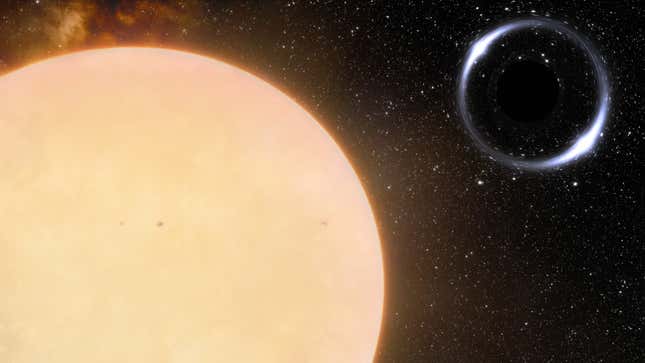
Scientists have discovered a relatively small black hole lurking next to a star in the constellation Ophiuchus, about 1,600 light-years away. It’s now the closest-known back hole to Earth.
Black holes are the densest objects in our universe (sorry, neutron stars). Whether they’re small, stellar-mass black holes or the supermassive ones at the centers of galaxies, the objects have gravitational fields so intense that not even photons of light can escape their event horizons.
The recently discovered black hole—named Gaia BH1—is three times closer to Earth than the previous record holder. Details about its discovery, as well as about the Sun-like star orbiting it, were published this week in the Monthly Notices of the Royal Astronomical Society.
The object was discovered using the Gemini North telescope in Hawaii, part of the International Gemini Observatory, in conjunction with data from the ESA’s Gaia spacecraft. The Gaia data suggested the star’s motion was slightly strange for a single object; it appeared as if the gravity of a massive object were affecting its motion.
Follow-up observations by Gemini North were done to determine the precise orbital period of the companion star, helping the team better estimate the mass of the unseen object.
“While there have been many claimed detections of systems like this, almost all these discoveries have subsequently been refuted,” said Kareem El-Badry, an astrophysicist at the Center for Astrophysics | Harvard and Smithsonian and the paper’s lead author, in a NOIRLab release. “This is the first unambiguous detection of a Sun-like star in a wide orbit around a stellar-mass black hole in our Galaxy.”
Keep in mind, a single light-year is about 6 trillion miles, so at 1,600 light-years distant the nearby black hole is only relatively nearby. Voyager—humanity’s farthest-traveled space mission—has been zooming away from Earth for nearly 50 years and is just under 15 billion miles away. Alpha Centauri, the closest star system to Earth, is about 4.24 light-years away.
Because light cannot escape black holes, they are most easily seen when they’re surrounded by superheated material they’ve accreted; such is the case for the black hole at the center of Messier 87 and Sagittarius A*, the black hole at the center of the Milky Way. Both of these black holes were imaged by the Event Horizon Telescope Collaboration, thanks to the warm glow of matter that allows you to see where the black hole lurks.
Black holes are much harder to spot when they’re not actively feeding; that is, when they aren’t accreting matter, superheating it, and releasing X-rays in the process. Such is the case with Gaia BH1, which is invisible except for its gravitational effects on the star.
“Our Gemini follow-up observations confirmed beyond reasonable doubt that the binary contains a normal star and at least one dormant black hole,” El-Badry said. “We could find no plausible astrophysical scenario that can explain the observed orbit of the system that doesn’t involve at least one black hole.”
But current models of binary systems involving a black hole and a star don’t explain Gaia BH1’s system. According to NOIRLab, the star that gave way to the black hole in the system would be massive, and it should have engulfed the other (i.e. still-existing) star in the system before the black hole formed.
Observing more black hole binary systems will in time help astrophysicists refine their models of how these systems take shape and evolve. Space observatories like IXPE and NASA’s NICER and NuSTAR will help in these efforts, by scrutinizing the high-energy X-rays emitted by feeding black holes.